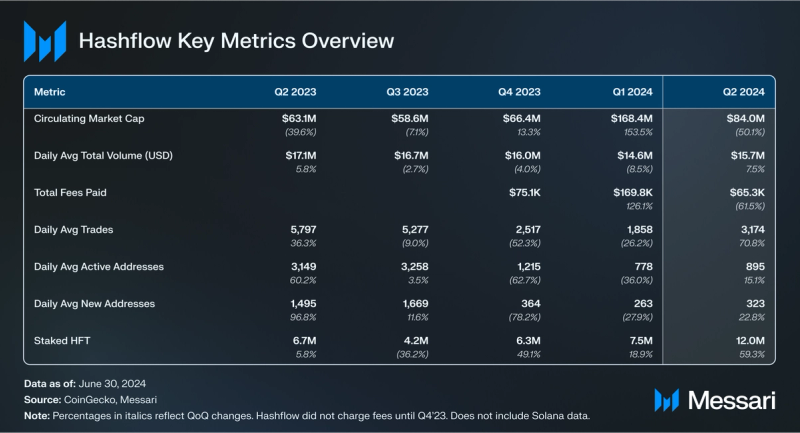Key Insights
- Daily average volume was up 8% QoQ to $15.7 million. L2 networks such as Arbitrum and Optimism drove the majority of trading volume increases in Q2.
- Daily average trades also increased, up 71% QoQ to 3,200. Ethereum’s EIP-4844 upgrade reduced gas fees on both Ethereum and its L2s, enabling cheaper trades on Hashflow.
- HFT staked reached the highest end-of-quarter amount to date, with a total of 12 million HFT being staked (+59% QoQ).
- After Q2 ended, Hashflow governance approved two separate governance proposals. The first governance proposal approved Hashflow’s deployment to Base, while the second involved the development of a zero-knowledge (ZK) settlement layer.
Primer
Hashflow (HFT) is a decentralized exchange (DEX) that uses a request-for-quote model with pricing provided by professional market makers. Hashflow’s signature-based pricing offers traders a guaranteed execution price, MEV resistance, and no slippage. The offchain order routing enables significantly reduced costs and allows market makers to compete on price with CEXs. After launching in Private Alpha in April 2021, Hashflow fully launched in August 2021. Since initially launching on Ethereum, it has expanded to Arbitrum, Avalanche, BNB, Polygon, Optimism, Solana, and Base (after Q2’24 ended).
Hashflow also offers cross-chain trading, allowing traders to exchange assets on different chains without escrowing or bridging assets between chains. HFT is the governance token for the Hashflow protocol. For a full primer on Hashflow, refer to our Initiation of Coverage report.
Website / X (Twitter) / Telegram
Key Metrics
Performance Analysis
Product Usage
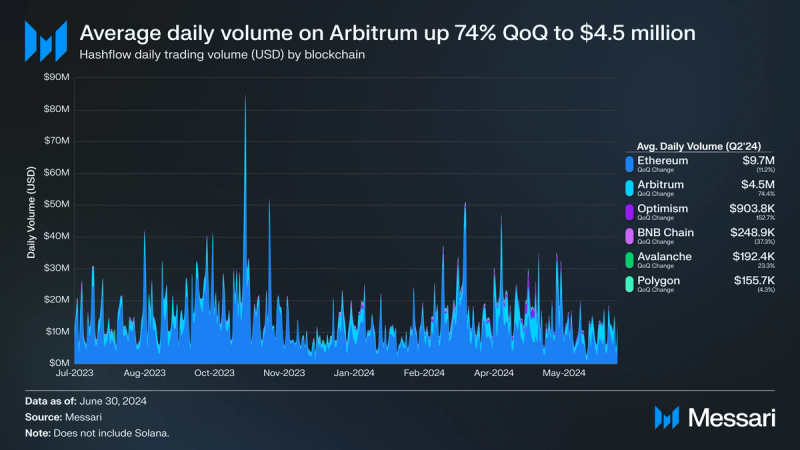
In Q4’23, Hashflow implemented a fee switch that would only take a fee when Hashflow’s price is significantly better than other options. The amount that is significant and how much of that amount that is taken is still being optimized and iterated on. Additionally, in November and December 2023, Hashflow transitioned to V3 contracts. These changes understandably resulted in initially lower volumes for Hashflow in Q1, as market makers needed to adjust to the changes.
In Q2, the initial impact of these changes on volumes seems to be fading. According to Messari’s State of Smart Contract Platforms Q2 2024 report, average daily DEX volumes saw a slight increase in Q2, up 1% QoQ to $5.3 billion. On a relative basis, Hashflow outperformed as its daily average volume increased 8% QoQ from $14.6 million to $15.7 million. Ultimately, as a DEX aggregator for most popular EVM-based Layer-1 chains and Layer-2 rollups, Hashflow’s trading volumes are mainly influenced by wider market activity.
Broken down by chain, Hashflow’s growth in Q2 mainly occurred on L2s. On Arbitrum, the leading L2 by bridged TVL, Hashflow’s daily average volume increased 74% QoQ from $2.6 million to $4.5 million. Hashflow capitalized on Arbitrum’s deep liquidity for both ETH-based and stablecoin-based trading pairs ($3.6 billion DeFi TVL and $4.0 billion in stablecoin market cap on June 30). The biggest gainer in percentage terms for Q2 was Optimism, where Hashflow’s daily average volume was up 153% QoQ from $357,600 to $903,800. Similarly to Arbitrum, Optimism maintains a significant portion of bridged TVL and supports deep liquidity for ETH-based and stablecoin-based trading pairs. The other Hashflow deployment that saw QoQ gains was Avalanche, which had its daily average volume increase 23% QoQ. Hashflow’s Ethereum volumes fell 11% QoQ from $10.9 million to $9.7. With Ethereum’s scaling roadmap primarily focused on L2 scaling, the gradual shift of trading volume from L1s to L2s is expected. For the entirety of Q2, each deployment’s share of trading volume on Hashflow is as follows:
- Ethereum – 62% of trading volume
- Arbitrum – 29% of trading volume
- Optimism – 6% of trading volume
- BNB Chain – 2% of trading volume
- Avalanche – 1% of trading volume
- Polygon – less than 1% of trading volume
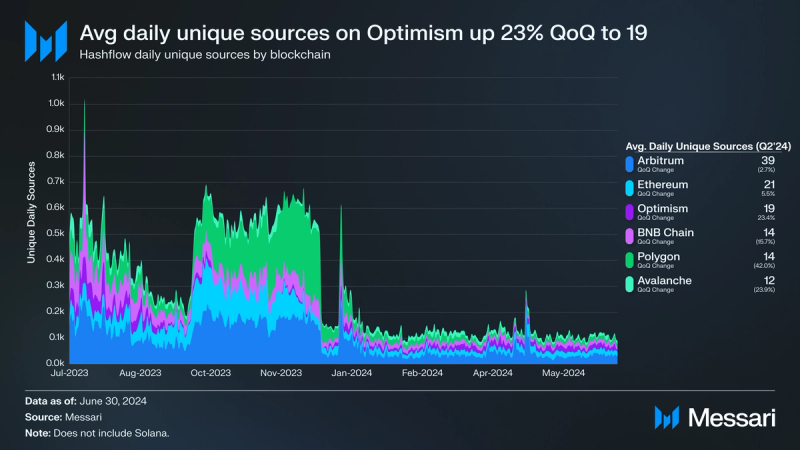
The number of daily active users (DAUs) measures how many externally owned accounts (EOAs) initiate transactions that get routed to Hashflow or use Hashflow directly. However, this report measures the number of direct contract interactions with Hashflow, not necessarily how many end users (i.e., EOAs) are driving those transactions. We count “Sources” to be native users and aggregation routers that use Hashflow, thus excluding EOAs that interact with an aggregator directly instead of Hashflow.
The average number of contracts transacting with Hashflow fell from 130 in Q1 to 118 in Q2 (down 10% QoQ). Note that the fall in unique sources is very different from the number of daily average addresses sending trades through Hashflow, which is likely due to the increased usage of integrations and move away from the Hashflow front-end or direct trading. This means Hashflow is positioning to compete for the best price execution, enabling its architecture and market makers to show the best price. This strategy favors winning the end consumer, where customer and volume acquisition can be more costly with very uncertain lifetime value.
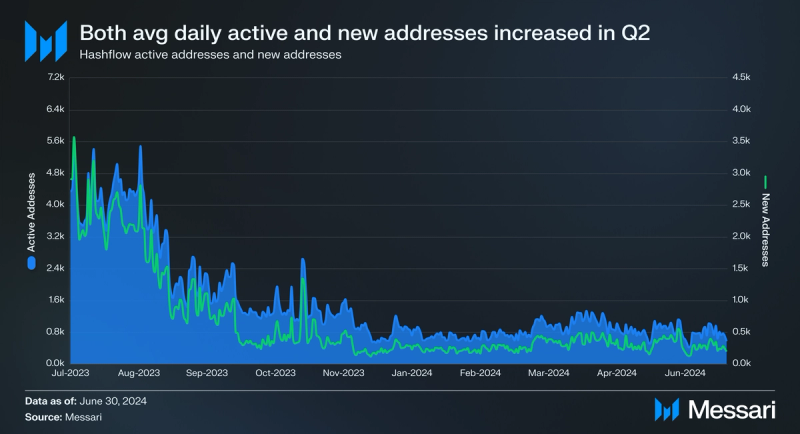
As for the raw number of traders interacting with Hashflow contracts (EOAs included), there was impressive growth in Q2. Average daily active addresses increased 15% QoQ from 778 to 895, while average daily new addresses increased 23% QoQ from 263 to 323. This was the first QoQ increase for both metrics since Q3’23.
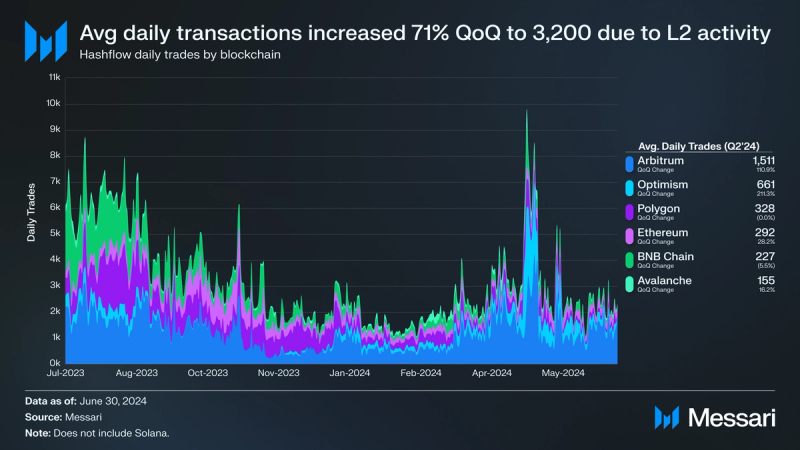
Trade count does not take into account the size of trades; instead, it largely displays the activity on rollups and alt-L1s, given their cheaper transaction costs. The average number of transactions per day increased by 71% from 1,900 to 3,200 in Q2. Similarly to trading volume, the majority of this growth occurred on L2s. Average daily trades on Arbitrum were up 111% QoQ from 716 to 1,511, while average daily trades on Optimism were up 211% QoQ from 212 to 661. Collectively, Arbitrum and Optimism accounted for 68% of trades on Hashflow in Q2.
Gas fees associated with L2s drastically dropped after April due to Etheruem’s EIP-4844 upgrade, which reduced L1 settlement costs for L2s. Additionally, this upgrade may have also had an impact on trade counts for Ethereum. Gas fees on Ethereum have also come down since EIP-4844, making it more affordable for smaller trade sizes. Average daily trades on Ethereum were also up, increasing 28% QoQ from 227 to 292.
HFT Distribution and Staking
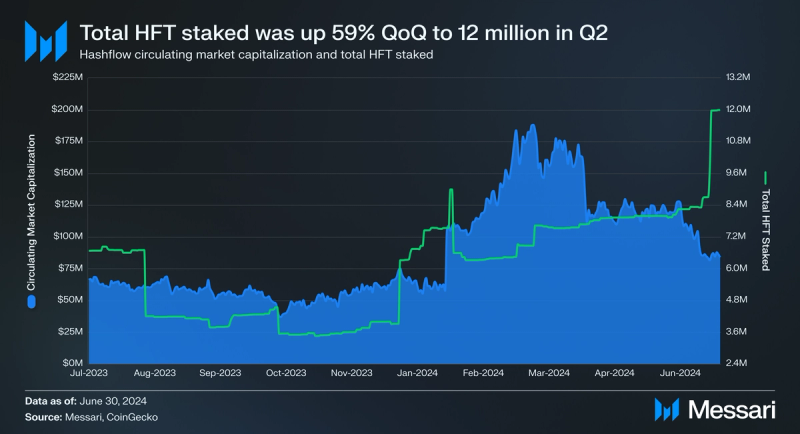
The overall crypto market experienced a pullback in Q2 after Q1’s hot start. After outsized performance in Q1, HFT’s circulating market cap decreased 50% QoQ from $168.4 million to $84 million. Despite this drop in market cap, HFT holders increased 2% QoQ from 13,000 to 13,300. The HFT token was also bridged to Arbitrum in June, making it more accessible for users.
HFT staked has been in a general upswing since Q4. This is mainly because of the community vote to turn on fees, which rewards stakers with 50% of protocol revenues. Therefore, as volumes and fees rise, the return on staking should also increase. Though the team is still early in optimizing the implementation of fees, the opportunity to provide real yield along with growth is unique in crypto assets and provides an attractive option for HFT stakers. By Q2 end, 12 million HFT was staked (up 59% QoQ from 7.5 million). This was also the highest end-of-quarter staked amount to date.
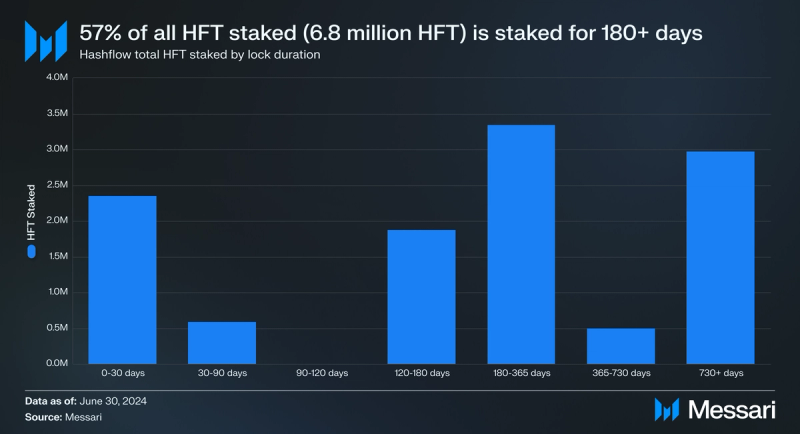
While the absolute amount of HFT staked increased in the quarter, the allocation of that stake was more impressive. HFT stakers have the option of locking up their stake for varying lengths of time. Longer locking times are beneficial for Hashflow, as it showcases user confidence in the underlying protocol. At the quarter’s end, 6.8 million HFT was staked for a period longer than six months (180+ days), representing 57% of all HFT staked.
Qualitative Analysis
Arbitrum Campaign
At the end of last quarter, Hashflow introduced a rewards campaign on Arbitrum. The goal of the campaign was to promote usage of Aggregator+ on Arbitrum, which launched in early March. Aggregator+ sources liquidity for trades both from solvers and and top DEXs such as Uniswap, SushiSwap, Camelot, and others. The campaign rewards 50,000 ARB tokens each week according to the following split:
- 30,000 ARB to the top 10 traders on Hashflow’s trader leaderboard
- 20,000 ARB to all remaining traders on Hashflow’s trader leaderboard.
Hashflow’s leaderboard is determined by trade volume, but sybil activity is filtered out. This campaign, in addition to the Aggregator+, has helped boost Hashflow’s trading volume on Arbitrum in Q2.
Deployment to Base
In June, the Hashflow Foundation posted a governance proposal to launch Hashflow and Aggregator+ on Base. Over the past year, Base has emerged as a leading L2 network, with over $6 billion in assets onchain and $1.9 billion in DeFi TVL, ranking it among the top three L2s by both metrics. Additionally, in Q2, Base benefited from popular projects such as Degen Chain and various memecoins. Deploying to Base gives Hashflow another avenue for both volume and revenue growth while also providing Base users and traders with better liquidity and swap pricing.On July 1, the Hashflow community overwhelmingly approved of Hashflow’s deployment to Base. 119 addresses controlling 239,000 veHFT participated, with no address voting ‘No’ on the proposal. Hashflow launched on Base after Q2 ended.
ZK Settlement Layer
Also, in June, the Hashflow Foundation posted a governance proposal to introduce a Zero-Knowledge (ZK) proof-based settlement layer to enhance security, privacy, and efficiency within the Hashflow ecosystem. This new layer will operate alongside existing infrastructure, improving transaction validation without exposing sensitive data. Benefits include increased scalability, lower transaction costs, and the potential for more advanced DeFi applications. The ZK settlement layer will also integrate with the HFT token, potentially boosting token utility and value. On July 2, the Hashflow community overwhelmingly approved of Hashflow’s development of a ZK settlement layer. 122 addresses controlling 373,000 veHFT participated, with no address voting ‘No’ on the proposal.
Closing Summary
Q2’24 marked a period of growth and strategic development for Hashflow. The platform saw an 8% increase in daily average trading volume, driven primarily by significant growth on Layer-2 networks like Arbitrum and Optimism. The number of HFT holders also increased, and staking reached a record high, with 12 million HFT staked by quarter’s end.
Hashflow also made key advancements, including the launch of a successful rewards campaign on Arbitrum and the community-approved deployment of Hashflow and Aggregator+ on Base. Additionally, the proposal to introduce a Zero-Knowledge (ZK) proof-based settlement layer was approved, signaling Hashflow’s commitment to enhancing security, scalability, and token utility.
These strategic initiatives and the community’s active participation position Hashflow well for continued growth and innovation in the evolving DeFi landscape.

